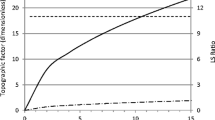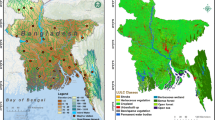Abstract
The universal soil loss equation (USLE) has been integrated with a geographic information system known as the geographical resources analysis support system (GRASS) to create a land classification system for use by military trainers and land managers to minimize the environmental impacts of military training activities. The USLE provides an estimate of current average annual sheet and rill erosion based upon factors representing climate, soil erodibility, topography, cover, and conservation support practices. The erosion estimate is compared to erosion tolerance values to produce an expression of the current erosion status. An index of inherent site erodibility is also achieved through manipulation of the USLE. Based on published soil surveys, satellite imagery, and ground-truth vegetation transects, data layers are created within GRASS for each of the component factors of the USLE. Appropriate mathematical operations are performed with the data layers, and color-coded maps are produced that represent the erosion status and erodibility index for each 50-m × 50-m area of soil surface. These maps aid military trainers and land managers in scheduling appropriate kinds and intensities of military training activities.
Similar content being viewed by others
Literature cited
Arnoldus, H. M. J. 1980. An approximation of the rainfall factor in the universal soil loss equation. Pages 127–132in M. De Boodt and D. Gabriels (eds.), Assessment of erosion. John Wiley & Sons, Chichester, England.
Benbrook, C. M. 1988. First principles: The definition of highly erodible land and tolerable soil loss.Journal of Soil and Water Conservation 43:35–38.
Blackburn, W. H. 1980. Universal soil loss equation and rangelands. Pages 588–597in Proceedings of the symposium on watershed management '80, July 21–23, 1980. Boise, Idaho. American Society of Civil Engineers, New York, New York.
Campbell, J. B. 1987. Introduction to remote sensing. Guilford Press, New York. 551 pp.
Coler, U. V. 1987. Topographical conservation measures and cultivation on military training areas. Pages 99–104in Proceedings—NATO committee on the challenges of modern society seminar, November 28–30, 1984. Soesterberg, The Netherlands. Blue Book 159, Preservation of flora and fauna in military training areas. US Army Construction Engineering Research Laboratory Conference Proceedings N-87/09. Champaign, Illinois.
De Boodt, M., and D. Gabriels (editors). 1980. Assessment of erosion. John Wiley & Sons, Chichester, England. 563 pp.
Diersing, V. E., and W. D. Severinghaus. 1984. The effects of tactical vehicle training on the lands of Fort Carson, Colorado—an ecological assessment. US Army Construction Engineering Research Laboratory Technical Report N-85/03. Champaign, Illinois. 46 pp.
Eriksson, J. 1976. Influence of extremely heavy traffic on clay soil.Grundförbättring 27:33–51.
Foster, G. R., and L. J. Lane (compilers). 1987. User requirements: USDA—water erosion prediction project (WEPP). US Department of Agriculture, Agricultural Research Service, National Soil Erosion Laboratory Report No. 1. West Lafayette, Indiana. 43 pp.
Gesch, D. B., and B. I. Naugle. 1984. An analysis of the utility of LANDSAT thematic mapper data and digital elevation model data for predicting soil erosion. Pages 260–265in M. M. Klepfer and D. B. Morrison (eds.), 10th international symposium on machine processing of remotely sensed data, June 12–14, 1984. Purdue University, West Lafayette, Indiana.
Gilliland, M. W., and W. Baxter-Potter. 1987. A geographic information system to predict non-point source pollution potential.Water Resources Bulletin 23:281–291.
Goran, W. D., L. L. Radke, and W. D. Severinghaus. 1983. An overview of the ecological effects of tracked vehicles on major US Army installations. US Army Construction Engineering Research Laboratory Technical Report N-142. Champaign, Illinois. 75 pp.
Klingbiel, A. A. 1958. Soil survey interpretation—capability groupings.Soil Science Society of America Proceedings 22:160–163.
Johnson, F. L. 1982. Effects of tank training activities on botanical features at Fort Hood, Texas.Southwest Naturalist 27:309–314.
Marsh, J. O. 1986. Memorandum for the Chief of Staff, US Army. Subject: Management of natural resources on army land. April 24, 1986. Washington, DC.
McCaleb, N. L. 1985. Soil survey of Coryell County, Texas. US Department of Agriculture, Soil Conservation Service. Government Printing Office, Washington, DC. 129 pp.
McCormack, D. E., K. K. Young, and L. W. Kimberlin. 1982. Current criteria for determining soil loss tolerance. Pages 95–111in D. M. Kral (ed.), Determinants of soil loss tolerance. American Society of Agronomy Special Publication 45. Madison, Wisconsin.
Onchev, N. G. 1985. Universal index for calculating rainfall erosivity. Pages 424–431in S. A. El-Swaify, W. C. Moldenhauer, and A. Lo (eds.), Soil erosion and conservation. Soil Science Society of America, Ankeny, Iowa.
Renard, K. G. 1987. Present and future erosion prediction tools for use in pinyon-juniper communities. Pages 505–512in R. L. Everett (ed.), Proceedings—pinyon-juniper conference, January 13–16, 1986. Reno, Nevada. USDA Forest Service General Technical Report INT-215, Ogden, Utah.
Rogler, V. H., and U. Schwertmann. 1981. Erosivität der niederschläge und isoerodentkarte bayerns.Zeitschrift für Kulturtechnik und Flurbereinigung 22:99–112.
Severinghaus, W. D., and W. D. Goran. 1981. Effects of tactical vehicle activity on the mammals, birds, and vegetation at Fort Lewis, Washington. US Army Construction Engineering Research Laboratory Technical Report N-116. Champaign, Illinois. 45 pp.
Severinghaus, W. D., R. E. Riggins, and W. D. Goran. 1979. Effects of tracked vehicle activity on terrestrial mammals, birds and vegetation at Fort Knox, KY. US Army Construction Engineering Research Laboratory Special Report N-77. Champaign, Illinois. 64 pp.
Spanner, M. A., A. H. Strahler, and J. E. Estes. 1982. Soil loss prediction in a geographic information system format. Pages 89–102in Papers selected for presentation at the sixteenth international symposium on remote sensing of environment, June 2–9, 1982. Buenos Aires, Argentina. Environmental Research Institute of Michigan, Ann Arbor, Michigan.
Stewart, J. A., A. T. Downs, and G. A. Stones. 1987. The impact of military training in Canada on indigenous flora and fauna. Pages 107–124in Proceedings—NATO committee on the challenges of modern society seminar, November 28–30, 1984. Soesterberg, The Netherlands. Blue Book 159, Preservation of flora and fauna in military training areas. US Army Construction Engineering Research Laboratory Conference Proceedings N-87/09. Champaign, Illinois.
US Department of the Army. 1978. Training land. Training Circular 25-1. Washington, DC. 166 pp.
Walsh, S. J., D. R. Lightfoot, and D. R. Butler. 1987. Recognition and assessment of error in geographic information systems.Photogrammetric Engineering and Remote Sensing 53:1423–1430.
Westervelt, J. D., M. J. Shapiro, S. J. Bradshaw, J. Bozack, N. Chandra, W. D. Goran, K. J. Griffin, A. Heekin, M. O. Johnson, M. S. Larson, R. C. Lozar, M. V. Martin, K. A. Norman, C. O'Neil, M. F. O'Shea, and L. Van Warren. 1987. Geographical resources analysis support system—GRASS, Version 2.0. US Army Construction Engineering Research Laboratory ADP Report N-87/22. Champaign, Illinois.
Wischmeier, W. H. 1959. A rainfall erosion index for the universal soil loss equation.Soil Science Society of America Proceedings 23:246–249.
Wischmeier, W. H. 1976. Use and misuse of the universal soil loss equation.Journal of Soil and Water Conservation 31:5–9.
Wischmeier, W. H., and D. D. Smith. 1978. Predicting rainfall erosion losses—a guide to conservation planning. US Department of Agriculture, Agriculture Handbook 537. Government Printing Office, Washington, DC. 58 pp.
Author information
Authors and Affiliations
Rights and permissions
About this article
Cite this article
Warren, S.D., Diersing, V.E., Thompson, P.J. et al. An erosion-based land classification system for military installations. Environmental Management 13, 251–257 (1989). https://doi.org/10.1007/BF01868372
Issue Date:
DOI: https://doi.org/10.1007/BF01868372




